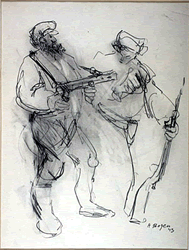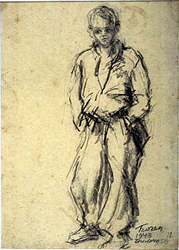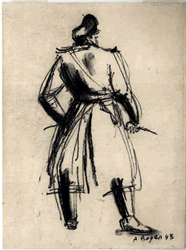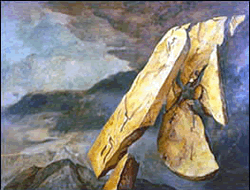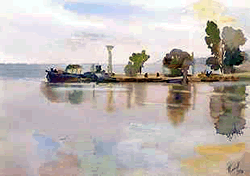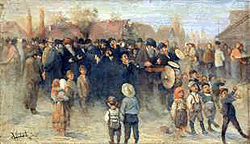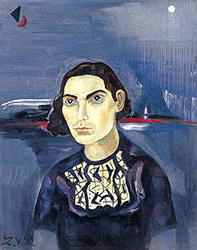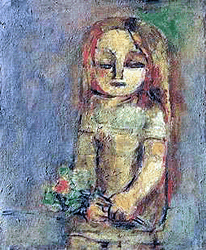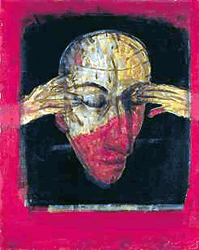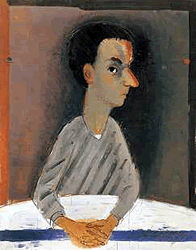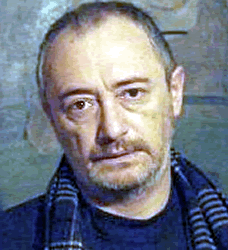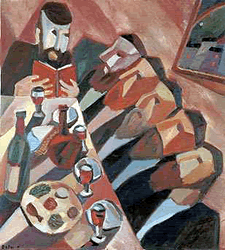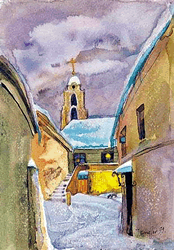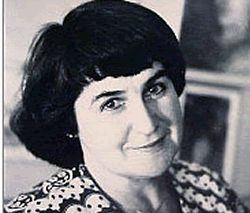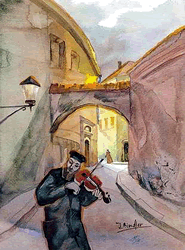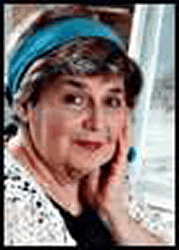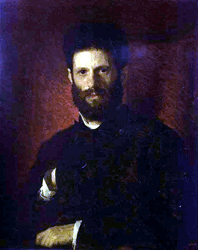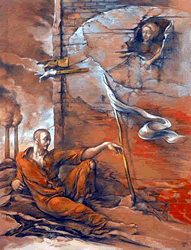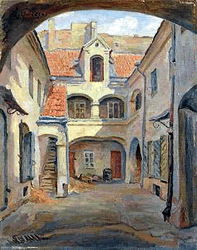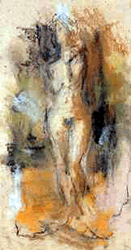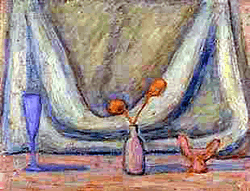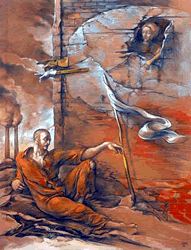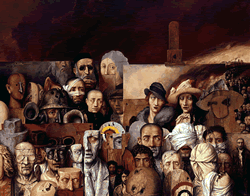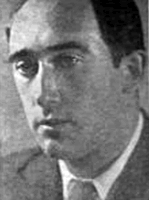I called artist Alexander Bogen/ Katzenbogen in Israel and told him about my translation of his chapter "The Onset of the Partisan Units in the Forest of Naroch"
From With Proud Bearing, 1939-1945: Chapters in the History of Jewish Fighting in the Naroch Forests
Edited by Moshe Kalcheim
Alexander asked me to include some text and pictures from the book "Revolt"
Revolt
Author Bogen, Alexander
Edition
Publication Name Beit Lohamei Haghetaot
Year 1989
Language English Hebrew
Description
4`, unnumbered pages, hardcover, dust jacket, ill., in good++ condition
Price $115.00
Cat. Number Kg 25 42 From the Internet;
"---In addition to all his other obligations and tasks at the time,
Alexander Bogen, a fighter and partisan commander, did not forget that
he was an artist, and documented and drew his partisan comrades.
During World War II, Bogen was the commander of a partisan brigade in
the Naroch forest in Belorus and infiltrated into the Vilna ghetto at
the most difficult period, when many of the public activists were in
despair over the certain destruction
In the framework of the F.PO. (United Partisan Organization),
he organized groups of Jewish
youth and led them to the forest, and the Nekama (Vengeance) partisan
brigade, which afterwards became famous for its fighting.
The artist was born in Vilna (Vilnius) in 1916, to the Katzenbogen family,
who were doctors, and he was the grandson of Rabbi Tuvia of Wolkowisk.
While still a youth, Bogen studies painting and sculpture at the faculty
of Art in the University of Vilna, and when the war was over he returned
to his studies there. In 1947 he completed his studies magna cum laude,
was appointed a professor in the advanced school of Art in Lodz, and
became famous in Poland as an artist and sculpture, set designer and
book illustrator. In 1951 he immigrated to Israelâ€■"---Dr.
Pnina Rosenberg, Curator
From the catalogue, the Ghetto Fighters’ House, 2001)
In the Ghetto Fighters’ House Museum art collection,
there are many works by the artist Alexander Bogen, which were produced
during World War II and immediately thereafter (1943-1949).
This exhibition focuses on Alexander Bogen’s work
in Israel, which, fifty years after the events, is ichonographically
connected to the work done during the Holocaust period.
Bogen’s drawings, especially those that survived from
the fighting of the partisans in the forests, are a first-hand testimony.
He creates a gallery of characters, of types, of situations, of a people
fighting for its life, which constitute the basis of the myth of the
revolt and the renascence.
The exhibition presents drawings for poems by two Yiddish poets, Gebirtig
and Sutzkever. Bogen’s drawings that accompany the
poems of Gebirtig have been published before (1997), but the drawings
for Sutzkever’s poems were done just now, or, more
accurately, have been collected and linked to the poems for this exhibition.
The two groups of poems are representative of Bogen’s
works, some of which were done in the past five years, but in terms
of theme, the drawings are connected with the period of the Holocaust
and the Revolt, and thus constitute a kind of closing of a circle in
his oeuvre. The exhibition thus presents the more graphic aspect of
Bogen’s art - works that accompany literary texts
in Yiddish, poems and prose - which constitutes one of the two main
axes in his oeuvre.
Â
 Curator of the exhibition: Sorin Heller
Alexander Bogen
Attack by Partisan Cavalry
no date
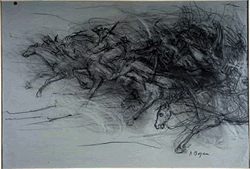
 choose  © Beit Lohamei Haghetaot
Pencil on grey paper, 46.7 x 66.7 cmSigned, lower right: A Bogen©
Beit Lohamei Haghetaot, Museum Number 741.
Donated by the artist
Portrait of Sidiakin, a Partisan
Commander
Narocz Forest 10 February 1944
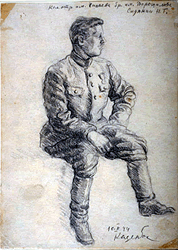
Pencil on paper, 28.2 x 20.2 cm
Inscribed (in Russian), upper right: Commisar of the Tsiapaiev unit
of the Varoshilov brigade, N.T. Sidiakin. Signed and dated, lower right:
Kazenbogen, 10.II.44
© Beit Lohamei Haghetaot, Museum Number 838.
Donated by the artistAlexander Bogen (1916-Â )
Group of Partisans in the Forest
Narocz Forests 1943
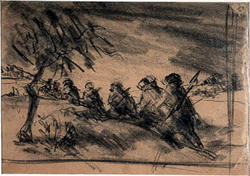
 choose  © Beit Lohamei Haghetaot
Charcoal on paper, 18 x 25 cmSigned (in Cyrillic letters) and dated,
on reverse, lower right: A. Bogen, 43, Narocz© Beit Lohamei
Haghetaot, Museum Number 599.
Donated by the artist
Alexander Bogen (1916-Â )
Partisan Eating
Lithuania 1943
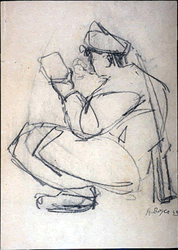
 choose  © Beit Lohamei Haghetaot
Charcoal on paper, 48 x 34.5Signed and dated, lower right: A. Bogen,
43© Beit Lohamei Haghetaot, Museum Number 881.
Donated by the artist
Portrait of Vice Commander Osenyenko Wearing Russian Fur Hat and a Medal
Lithuania 3 January 1944
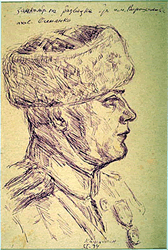
 choose  © Beit Lohamei Haghetaot
Purple ink on paper, 24.6 x 16.8 cmInscribed (in Russian), upper part:
Vice Commander of the patrol unit, of the Varoschilov brigade, Osenyenko.
Signed (in Cyrillic letters) and dated, lower center: Kazenbogen, 3.I.44©
Beit Lohamei Haghetaot, Museum Number 1437.
Donated by the artist
Alexander Bogen (1916-Â )
Two Partisans
Narocz Forests 1943
 choose  ©
Beit Lohamei Haghetaot
Pencil on paper, 65 x 50 cmSigned and dated, lower right: A. Bogen,
43© Beit Lohamei Haghetaot, Museum Number 746.
Donated by the artist Youth
Vilna 1943
 choose  ©
Beit Lohamei Haghetaot
Charcoal on paper, 27 x 20 cmSigned (in Cyrillic letters) and dated,
lower right: Bogen, 1943, Vilnius© Beit Lohamei Haghetaot,
Museum Number 594.
Donated by the artist
Bogen donated some of his works from the war period to the art collection
of Beit Lohamei Haghetaot (the Ghetto Fighters' House Museum). He has
spoken about the nature of his war works and the reasons he produced
them:We saw forsaken children. We saw people being taken for slaughter.
I could not let my pencil fall. An artist doomed to death recording
and so preserving those doomed to death. Was this a purely aesthetic
purpose? Was I at ease with my conscience when I took a bereft mother,
a forsaken little girl or a dying old man as my models? As a partisan
I recorded in telegram style, so to say, while on my way to some action,
leaning over my rifle or standing tensely in ambush. I sketched the
forest, my brothers-in-arms, the battle itself. There was no table.
There were no paints. There was no paper. I found packing paper. I burnt
dry branches and prepared charcoal for my sketches.A partisan newspaper
was published by the Brigade. I made woodcuts with my pen-knife and
prepared them for the mobile press. Wherever I found myself I collected
scraps of paper and went on sketching.I asked myself why I was drawing,
when I was fighting day and night. This is something similar to biological
continuity. Every man, every people, is interested to continue his people,
his family, to bring his creative children for the future - to leave
this one thing. Another motivation was to bring information to the so-named
free world about the actions, the cruel, cruel actions of the Germans
- some documentation. To tell about this to a world that was uninformed
- To be creative in the situation of the Holocaust, this is also a protest.
Each man when he is standing face to face with cruel danger, with death,
reacts in his way. The artist reacts with his means. This is his protest!
This is my means! He reacts in an artistic way. This is his weapon.
He must leave his mark as a mensch on mankind. This, it shows that the
Germans could not break his spirit.[1]
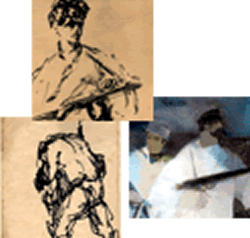
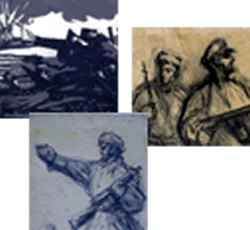
The Pen and the Sword:
Jewish Artist and Partisan, Alexander Bogen
 The “Ubermensch�
in the pose typical of the “Master Race�Oil
crayon on paperGift of the artist,1943Â Â
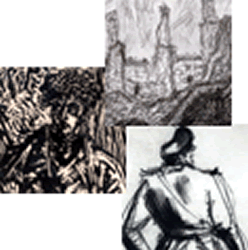
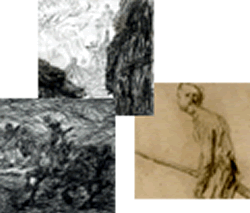
The first major look at the complex subject of Jewish efforts to fight
back against the Nazis and their collaborators in Eastern Europe. Told
by partisans themselves, without a narrator, and filmed in Lithuania,
Poland and Israel, the film uses black and white imagery of the partisan
forest hideouts, rare archival footage, historical photographs and original
artwork by partisan fighter Alexander Bogen to document this little
known history. Surviving partisans tell of the circumstances that enabled
them to make a decision that not every Jew could - the decision to fight
back.
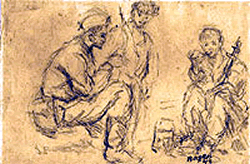
Alexander Bogen (b. 1916), A Fighters’ Meal, 1943,
pencil on paper
The Pen and the SwordÂ
Jewish Artist and Partisan, Alexander Bogenby Shachar Leven After
infiltrating the Vilna ghetto on a precarious rescue mission only days
before its final liquidation, Alexander Bogen—Jewish
artist and partisan—was plagued by a reverberating
question: “What motivates someone at the precipice
of death to engage in artistic creation?�An artist and
a native of Vilna, Bogen neither forsook his artistry nor ceased sketching
the people, places, and events he encountered following the Nazi occupation
of Lithuania. However, it was only after infiltrating the ghetto in
September 1943 that he began considering the wartime function of innovation:
to transform pen into sword, transcend the finite parameters of time
and space, and retain a spark of humanity in the face of despair. These
artistic objectives crystallized in his mind through encounters with
ghetto residents, former friends, and colleagues: the fellow-artist
who stood by his easel—half-naked and starving—yet
oblivious to his condition having captured the elusive smile of his
model on canvas; the all-around genius who wandered the streets past
curfew heedless of his personal fate having solved an elaborate mathematics
equation; the young orphan abandoned on a street corner who Bogen—an
armed partisan—could not save, so sketched “out
of helplessness, passivity, and the inability to offer up salvation.�
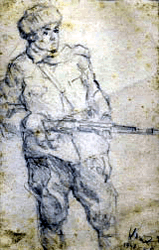
Alexander Bogen (b.1916), A Jewish Partisan in the Voroshilov Brigade,
1943, Pencil on paper. Donated by the artist
Aside from reinforcing his personal devotion to art, Bogen’s
mission in the ghetto helped facilitate the successful rescue of members
of the United Partisan Organization (FPÖ)—a
Jewish underground movement active in the ghetto. After breaching the
ghetto walls armed with a pistol and two hand grenades, Bogen—along
with two fellow partisans—reached FPÖ
head, Abba Kovner’s headquarters. Bogen presented
him with a letter from Fyodor Markov, commander of the partisan division
in Belarussia’s Narocz Forest.“From
the beginning, Kovner’s intention had been to launch
a full-scale armed revolt in the ghetto to sanctify God’s
name and foster pride in the Jews even in their moment of defeat,�
recalls Bogen. “It was a noble conception, but not
practical in my opinion. We couldn’t fight the Nazis
in the narrow alleyways of the ghetto with our few, primitive weapons.
We would have zero chance.�With the end in sight, Kovner
did not abandon his plans for revolt, however acceded to the partisans’
request to smuggle ghetto residents (including members of the FPÖ)
to the forests.One hundred and fifty Jewish underground members were
assembled and divided into five units which Bogen helped train: “I
distributed primitive weapons and copies of my map of the forest. I
taught them how to prepare for and fight the enemy, find food, read
a compass, where to hide, and where and when to walk—all
the tactical information one needs to become a partisan,�
says Bogen. He assumed command of one the units, which included his
wife, Rachel, and his mother-in-law. In the late night hours he helped
secure the groups’ escape from the ghetto; a few days
later, all five units arrived safely in the forests where they joined
the non-Jewish partisan ranks.With Markov’s permission,
Bogen retained command of his 30-person unit, which became the only
all-Jewish partisan brigade—Nekama (Vengeance). The
unit achieved many successes and was responsible for missions such as:
mining railroad tracks and derailing trains, sabotaging German weapons
banks and food rations that were being sent to the front, and disseminating
information about the mass extermination and active resistance in the
nearby ghettos, villages, and towns.
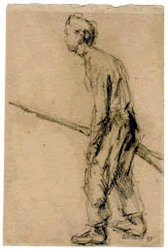
Alexander Bogen (b.1916),
A Partisan on Alert, 1943, charcoal on paper
Partisan life was stark and grueling. Aside from risky reconnaissance
missions and clashes with the enemy, fighters suffered from exposure
to the elements, insufficient food, and illness. For Jewish partisans
the conditions were even more dire: They had to face the residual “tragedy,
mental torment, longing, and worry about the fate of loved ones left
behind in the ghetto,� notes Bogen, as well as antisemitic
treatment from non-Jewish partisans. “Jewish partisans—especially
those who served in mixed units with Russians, Letts, and Belarussians—always
had to prove they were willing to volunteer first for missions and risk
the most,� says Bogen. “They were often
sent poorly armed on “hopeless’ operations
that had little chance of success.�Even the Nekama Unit
became problematic to the Soviet partisan leadership due to its all-Jewish
character, despite its many achievements. The unit was disbanded after
several months and Bogen (after a few other appointments in mixed units)
was commissioned, alongside another partisan, to document partisan activities.Bogen
captured his brothers-in-arms through the medium of art, sketching scenes
of partisan battle, rest, ambush, dress, and diversion on random scraps
of paper using charcoal made from burnt branches. “I
would try to record the typical situations that we would encounter—a
unit returning from its operationâ€■ its members sitting
around a bonfire, playing cards, drinking Vodka, recounting the tales
of what befell themâ€■â€? says Bogen. “In
battle, at partisan headquartersâ€■ I would pull out my paper
and sketch these things as they were happening, as a reaction to the
events taking place.�“Ultimately, when
I asked myself why I was drawing, when I was fighting day and nightâ€■
[I realized that it was] something similar to biological continuity.
Every man, every people wishes to leave this one thingâ€■
To be creative during the Holocaust was also a protest. Each man when
standing face to face with cruel danger, with death, reacts in his own
way. The artist reacts in an artistic way. This is his weaponâ€■This
is what shows that the Germans could not break his spirit.â€?Â
Alexander Bogen has recently donated 37 of his works created during
his days as a partisan to Yad Vashem’s Art Museum.
Several of these pieces will be exhibited in Yad Vashem’s
new Holocaust History Museum in the section dedicated to Jewish fighting.Â
Related Links:Online Exhibition: The Pen and the SwordCopyright ©2004
Yad Vashem The Holocaust Martyrs' and Heroes' Remembrance Authority
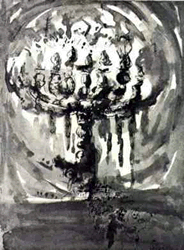
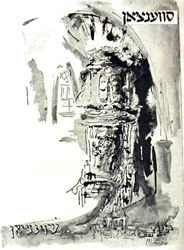
Samuel Bak (b. 1933), Thou Shalt Not Kill, 1978, Oil on canvas
Samuel Bak was born in Vilna, and began to draw at an early age. His
drawings were displayed in the Vilna ghetto, where he lived with his
mother. Bak's father was killed just a few days before Vilna was
liberated by the Russians. After the war's end, he was sent to refugee
camps in Germany, and emigrated to Israel in 1948.
Thou Shalt Not Kill is a diptych, with the two Tablets of the Covenant
constituting the central motif in both sections. In the lower section
of the diptych, Bak uses the broken Tablets as a symbol of the
artist's loss of faith in God in the wake of the Holocaust. The God
who failed to watch over his children and abandoned his people, the
Chosen People who were entrusted with the Tablets of the Covenant. The
two Tablets of the Covenant containing the Ten Commandments, intended
as an eternal moral code, were broken due to the wrongdoing of
mankind. The broken Tablets are cast into a grave, also in the shape
of the Tablets of the Covenant, with blood dripping from its peeling
walls. The broken Tablets signify the loss of faith, and the grave in
the form of the Tablets of the Covenant is a symbol of the
annihilation of the Chosen People, God's people, who preserved the
Jewish tradition, and were sent to the crematoria. Bak separates the
words "Thou Shalt Not" and "Kill", and thus the opposite meaning to
the one intended in the Ten Commandments is implied. The word "Kill",
which appears four times, reverberates in the empty grave under the
words "Thou Shalt Not". This is the scene which unfolds before the
viewer, who feels as though he himself is standing on the edge of the
open grave.
In the upper section of the diptych, the broken tablets hover over a
desolate, apocalyptic vista. The letters have fallen off the broken
tablets of stone, leaving only bullet holes, a reference to the blood
on the sides of the grave. The name of the picture, "Thou Shalt Not
Kill" is deeply ironic, a protest against the murder which has already
been committed.
OHEL MAN-KATZ (1894-1962) was born in Kremenchug, Ukraine, a province of the Russian Empire. He studied in religious schools and was expected to become a Rabbi. At age 16, however, young Ohel developed an interest in art. In due time, he graduated from the Vilnius School of Art and the Academy of Art in Kiev. In 1913 he moved to Paris, along with many promising artists of the day. He enrolled in the prestigious École Nationales des Beaux-Arts and studied under Fernand Cormon, teacher of Vincent van Gogh. It was there he befriended Soutine and Chagall. Who knows who influenced whom during those formative years? Parenthetically, we don’t even know why the young man enlisted in the French Foreign Legion. [Thankfully, he was rejected.] We know that Chagall and Katz wound up with similar styles and common [religious] themes. At the outbreak of WWI the artist returned to Russia, only to surface in Paris again soon after. He became a citizen of France in 1927. Now famous, the artist traveled to Palestine and established a workshop in Haifa, a city destined to become his artistic residence. The artist bequeathed hundreds of paintings and sculpted works to his "adopted ancestral home." Even though Mané-Katz was a fine sculptor, he is known to the world as an exemplar of Jewish Expressionism, a painter. Today a museum in Haifa is dedicated to his work. One of his paintings, Rabbi in a Yellow Gown, is on display at the Vilna Gaon Jewish Museum. The artist died in Tel Aviv.
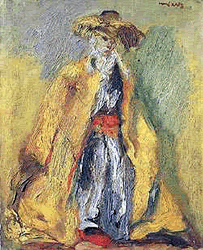
Rabbi in a Yellow Gown
Date 1920's
Percov, Michail
Michail Percov (1919-2001) is a complicated man with a complicated history. His voyage to the world of art was equally circuitous. Percov was born in Kazan, the capital of Tatarstan, an ancient land with ties to Russia. When Michail was a boy, his entire family was moved to Odessa, a Ukrainian city known for its cultural prowess, not the least of which was P.S. Stoliarskij Music School that educated David Oistrach. Percov, on the other hand, attended trade school and started working in a factory. But in the evenings he studied art. His father introduced the young Percov to I. Nazarov, a famous painter working for Odessa Opera and Ballet. His influence was essential. Percov later studied under M. Suchatova and Professor L. Muchnic at Odessa School of Art. In 1932, however, Joseph Stalin engineered a famine in the Ukraine. Millions of people died. Percov survived. When Russia invaded Finland in 1939, Percov was conscripted into the Red Army, his career disheveled again. Eventually, the artist was wounded. By 1946 most of his works of art were lost or scattered G-d knows where. He then moved to Lithuania, married a woman in Vilnius and began to paint once more, all the while working on various projects in drama theater and cinema. One of his exhibitions in Vilnius featured Judaic themes, including paintings of life in the Jewish ghetto. Many found their way into foreign countries, including the United States. Sentimental Mood is on display at Vilna Gaon Jewish Museum. Â
Ch. Fefer
Holiday
Date 1902
Zavadskiene, Elena
ELENA ZAVADSKIENE (b.1943) was born in Odessa, Ukraine during World War II when her country was a battleground for Nazi Germany and Soviet Russians. Elena, on the other hand, was interested in music, art and poetry. [She wrote poems in three languages: Ukrainian, Lithuanian and Polish.] By the time she was nineteen, the artist graduated from the Art and Theater Institute in Odessa. She was influenced by French Impressionism, a forbidden style that could only be self-taught by fine art reproductions and catalogs of art. As she continued to work in a style officially condemned, Elena became a makeup artist for actors in theatrical and cinema. Not surprisingly, she was good at her job and became well-known. Accordingly, she was invited to Lithuania for a major movie production. It was here that Zavadskiene would stop painting human faces and concentrate on painting on canvas. As a consequence, her talent as an artist could no longer be concealed. She held 15 solo exhibitions in Lithuania, one in Holland and many more in group exhibits elsewhere in the world. Gradually, her paintings were displayed in many museums, like the Vilna Gaon Jewish Museum. Today, her paintings have found their way to private collections in Holland, Germany, France, Belgium, UAE and the United States. The artist is represented online by the Jewish Art Network. The Portrait of Sergey's Mother was provoked by heart wrenching circumstances that shed light on the artist and the person - Elena Zavadskiene.
Zavadskiene, Elena
Portrait of Sergey's Mother
Date 1990Â function f_showVGMPopUp_152() { VilnaGaonPopup_152.style.posLeft = VilnaGaonPopup_152.offsetLeft-350 VilnaGaonPopup_152.style.visibility = 'visible'; } function f_hideVGMPopUp_152() { VilnaGaonPopup_152.style.posLeft = VilnaGaonPopup_152.offsetLeft+350 VilnaGaonPopup_152.style.visibility = 'hidden'; } from Jewish Art Network online gallery, representing Vilna Gaon Jewish Museum. In concordance with the Council of Europe, we support the Vilna Ghetto project with a contribution to the museum from this sale.
 Original Medium Oil on CanvasÂ
 Original Dimensions 28.7 x 36.2" (73.0 x 92.0cm)Â
 Print Type Iris Giclée PrintÂ
 Print Substrate CanvasÂ
 SKU# J0049_OI_MA_0001LÂ
Â
Open EditionThe story behind this painting takes us well beyond the usual conventions of art. It's a story of a mother who lived in Lithuania and perished - without a trace - in the Nazi Holocaust. She might have been aware of her impending doom, as she was forcefully confined inside a Jewish ghetto by a gang of Wehrmacht troops http://www.jewishartnetwork.com/Shopping/imgPopup.asp?authID=1750923032&imgName=L_152.jpg&imgTitle=Portrait+of+Sergey’s+Mother
Kulvianskij, Isaya
ISAYA KULVIANSKIJ (1892-1970) was born in Jonava, Lithuania. He studied at Vilnius Art School, the Berlin Academy of Art [under Professor Hugo Kaufman] and École des Beaux-Arts in Paris, where he collaborated with M. Chagall and H. Sutin. Kulvianskij served in the Russian Army during World War I. He moved to Palestine in 1933, founded a school of art and taught there for seventeen years. As an artist he was exceptionally talented and mastered everything he ever tried, including wood sculpture, sculpting in stone and painting in oil. As a stylist, Kulvianskij is tough to nail down. In his youth he was a member of the radical Berlin November Group. By way of neo-realism, he became acquainted with the German painter, Lovis Corinth, who did make an impression on the independent-minded Kulvianskij. Corinth was a progressive post-impressionist who used color with rustling visions, much as we see in the painting of his illustrious student, A Girl. In 1950, the restless artist moved from Palestine to Europe, spending time in Germany and France. He finally settled in London, where he worked for the rest of his life. The artist died in 1970. One of his paintings, A Girl, is on display at the Vilna Gaon Jewish Museum. Additional works by Kulvianskij are found in museums and private collections all over the world.
MICHAEL YAKHILEVICH (b. 1956) was born in Moscow. His family was known for artistic and literary eminence ( from the Vilna region). However, any form of self-_expression was forbidden in Soviet Russia. Yakhilevich's great uncle, a poet, was shot by the Soviets in 1941. His grandfather, the renowned artist Meir Axelrod, escaped execution but he was exiled to Kazakhstan. [Axelrod returned to Moscow in 1944.] The young Yakhilevich studied art with his grandfather from 1963 until the elder's death in 1970. With the advent of Perestroika, Michael and his mother emigrated to Israel, where he founded Mesilot, an organization of Russian artists. [His mother, Elena Axelrod, is an accomplished poetess and winner of Israel's Writers' Union Award in 1996.] Among his many talents, Yakhilevich is accomplished in theater, graduating in stage design from Artistic Theater College in Moscow. He's been involved in over 50 theatrical productions. The influence of his famous grandfather is also apparent. One is quickly drawn to a Yakhilevich painting. The geometric, three-dimensional quality of his works is characteristic. His paintings may be found in museums, galleries and numerous private collections in Israel, Russia, Lithuania, France, Holland, Germany, USA, Japan, Poland and Romania. An example of his work is on display at Vilna Gaon Jewish Museum. "Breakfast" was painted in 1989 when the artist was living in Moscow.
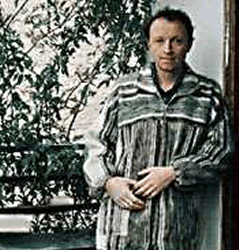
Wise Men at the Passover Table
Date 1993
http://www.jewishartnetwork.com/Shopping/proddetail.asp?authID=1750923032&pid=255&PreviousPage=browse%2Easp%3FauthID%3D1750923032%26aID%3D19
IZABELE BINDLER (Vladivostok 1932-2003 in Vilna) was born in Vladivostok, Russia. Between 1951 and 1957 she was a student at Lithuanian Art Academy. After graduation, she tried her hand at posters and "estampe," in the grand tradition of Toulouse Lautrec. However, she would soon become attracted "to colors of the Baltic dunes, forests and lakes," devoting her talent in that direction and to the portraits of interesting people. Her works of art are usually rendered in transparent watercolor, reflecting the softness of her creative mood. Bindler's paintings are found today in galleries throughout the world, including Austria, Germany, Cuba, Paris, London, Israel and Russia.
Mark Antokolsky (1843-1902) is an outstanding Russian sculptor of Jewish origin, studied in the St. Petersburg Academy of Arts (1862-68). Because of poor health lived mostly in Italy, visiting Russia from time to time. Executed commissions for Russian cities, e.g. Monuments to Peter I in Archangelsk and in Taganrog...
(from the internet)
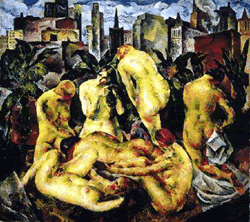
William Samuel Schwartz was born in Smorgon, Vilna region, on February 23, 1896 and died in Chicago February 10, 1977. He studied at the Vilna Art School in Russia from 1908 to 1912.
At the age or sixteen he immigrated to America and three years later entered the Art Institute of Chicago where he was awarded a scholarship. To help support himself, he worked 16 hours a day waiting on tables, ushering in theatres, singing in concerts and operas. In 1912, the year after graduation from the Sch.....
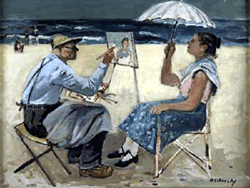
Landscape and figure painter Nicolai S. Cikovsky, 1894-1987, was born in Russia, where he studied at the Vilna Art School, 1910-1914; the Penza Royal Art School, 1914-1918; and Moscow High Tech Art Institute, 1921-1923. He emigrated to the United States in 1923, exhibiting in that year in New York City at the Charles Daniels Gallery. In 1942, Cikovsky began spending summers on Long Island, New York, in the North Sea area, where he moved permanently in the late 1970s. He painted many land and sea
Samuel B
Samuel Bak, Adam & Eve, 2000, crayon and oil on brown paper
Samuel Bak
was born in 1933 in Vilna, Poland and was recognized from an early age as possessing extraordinary artistic talent. As Vilna came under German occupation in 1940, Bak and his family moved into the Vilna ghetto, and later to a labor camp, from which he was smuggled and given refuge in a monastery. At the end of the war, his mother and he were the only members of his extensive family still alive.
....
...spent his life dealing with the artistic _expression of the destruction and dehumanization which make up his childhood memories. He speaks about what are deemed to be the unspeakable atrocities of the Holocaust. He has created a visual language to remind the world of its most desperate moments.
This exhibition is jointly sponsored by the Judaic Studies Program and the College of Media Arts and Design of Drexel University. Courtesy of Pucker Gallery, Boston
www.drexel.edu/judaicstudies/jsartBak.html
Chvoles, Rafael
View of Old Vilnius
Date 1954
RAFAEL CHVOLES, a.k.a. RAFAEL KHVOLES (b. 1913) was born in Vilnius. He studied in the private studios of M. Kuliesa and A. Sturman and began to exhibit his work in 1933, the same year Hitler became Chancellor of Germany. After World War II, he lived in Warsaw and Paris. He is known for his depictions of the Jewish Quarter in Old Vilna. He is also known for painting moving portraits of Vilna Ghetto survivors. Many of his paintings are found in Lithuania. Yard in Vilnius Old Town is on display at the Vilna Gaon Jewish Museum. The artist lives in Paris.
LEONID PAVLOVICH ZUSMAN (1906 - 1983) was born in Grodno, Belorussia. In recognition of his talent, he attended the Free Art Studios at age thirteen. He was obviously a child prodigy. Leonid Zusman is best remembered in the annals of history as a graphic artist. As a young man, he studied under private tutors and at the Leningrad Academy of Arts [1924 - 1926]. He began to exhibit his work in 1928. Jewish Art Network is privileged to offer ....
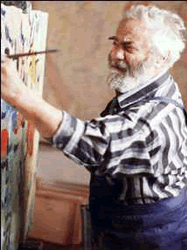
It's difficult to classify ARON BUKH (b. 1923) in any reasonable way. We have him listed as "contemporary" only because we don't know what else to do. In his own words: "My artistic credo is flying [by the seat of his pants, I might add]. Nothing else is good for me. One wing is color; the other is light." Bukh was born 80 years ago in Ukraine when the original Vladimir ruled Soviet Russia [not to be confused with Putin]. When he was eighteen, he enrolled at Moscow's School for Artistic Education, controlled by the Man of Steel. The year was 1941, a time of Soviet expansion and Hitler's double-cross of his erstwhile partner in crime. It launched the Great Patriotic War. Bukh completed his studies in 1944 and was promptly ordered to work in a factory, a glorious job in the Worker's Paradise. However, as soon as he could - two years later - he resurfaced as an artist. In those times, artists survived by compromise or conflict. We don't know exactly how he did it; we only know that Aron Bukh survived. He became a member of the Artists Union and was allowed to display his work. Aron's first exhibition took place in 1985 and immediately established him as a great artist in the Soviet Union. International fame would follow, with solo exhibitions in Germany, USA, France, England, Spain and India......
ILYA TABENKIN (1914-1988) was born in Mozyr, Belarus, shortly before the First World War. His family was deeply religious, an influence revealed in all of his creative works. In a favorable review, Tabenkin's paintings were described as "narrow spheres and magic circles ... where figures are signs and drapery holds sacred meaning," all conveyed through a balance of delicate mass, weight, gesture and placement. Some of his works may be considered visual equivalents of prayer. On the surface, one finds sad and funny figures, treated in whimsical manner - birds and animals doing whatever birds and animals do, on a background of drapery resembling curtains in a theater. Otherwise, there is no glitter, no tinsel, no political statement, as expected in Soviet and post-Soviet Russia. Instead, Tabenkin offers art as a means of investigating Good and Evil. The artist painted tragedy, likened to the soul of man doomed in a Siberian Gulag, an impression drawn from personal experience. Rejecting any and all Soviet "guidelines," Tabenkin turned to his religious roots, a struggle of spirit in chaos, of wisdom in madness. Ilya Tabenkin died in Moscow just before the USSR itself would disappear......
From http://www.jewishartnetwork.com/JewishArt/vilna_gaon.asp
....The Museum was renamed after Elijah ben Solomon Zalman, the famous Gaon of Vilnius. The Vilna Gaon Jewish Museum became fully energized as it began its work, collecting information about Lithuanian Jews and the erstwhile culture of Litvakia. Today, the Museum holds permanent exhibitions on the Holocaust, long-forgotten posters of the Ghetto Theater, numerous models and photographs of The Great Synagogue, Purim dolls and other historical memorabilia.The Museum also maintains an exhibit honoring ethnic Lithuanians who risked their lives in order to rescue and hide Jews from the German Nazis during the Holocaust period. Extensive research by Museum staff has resulted in numerous publications, including a listing of Vilnius Ghetto prisoners, a guide to the Jewish Community in Vilnius and similar restorations of historical memory. A Judaic Library is attached to the Museum. Last, but not least, the Museum owns many works of art by renowned artists like Max Band, Mané-Katz, Rafael Khvoles, Isaya Kulvianskij and an assortment of modern painters and sculptors. To expand its worldwide visibility through cyberspace, the Museum recently signed an agreement with the Jewish Art Network, an international Internet art gallery. The Vilna Gaon Jewish Museum receives visitors from Lithuania and nearly every corner of the globe. Until you are able to come to Vilnius, feel free to browse through the Vilna Gaon Jewish Museum courtesy of the Jewish Art Network.
- Roza Bieliauskiene, Curator, Vilna Gaon Jewish Museum
go to;
http://www.jewishartnetwork.com/Shopping/browse.asp
1876
Samuel Bak
Information from the net;
Shmuel Bak began his artistic career as a "vunderkind" of the Vilna
Ghetto, attracting the support and admiration of such cultural
luminaries as Avrom Sutzkever, Shmerke Kaczerginski, and Herman Kruk.
In 1941 both of Bak's grandfathers were taken to the Ponar forest
where they were shot, together with other Jews. On the following Yom
Kippur holiday, both his grandmothers were also taken to that forest
and executed. Bak's father was shot by the Nazis a few days before the
liberation of the Vilna ghetto. Bak and his mother managed to survive
the liquidation of the ghettos and the labor camps by hiding
successfully during the German occupation. Since surviving those
perilous years, he's become a world renowned painter who has had over
200 solo exhibitions throughout the world.
Samuel Bak, Painter. b. 1933, Vilna. Immigrated 1948. Studies:
Bezalel, Jerusalem; Beaux Arts, Paris. 1959-1966 Lived in Italy where
he developed his style. Prize: 1956 America-Israel Cultural
Foundation. From 1993 living in U.S.A.
Samuel Bak was born in 1933 in Vilna, Poland and was recognized from
an early age as possessing extraordinary artistic talent. As Vilna
came under German occupation in 1941, Bak and his family moved into
the Vilna ghetto, and later to a labor camp, from which he was
smuggled and given refuge in a monastery. At the end of the war, his
mother and he were the only members of his extensive family still
alive.
Bak has spent his life dealing with the artistic expression of the
destruction and dehumanization which make up his childhood memories.
He speaks about what are deemed to be the unspeakable atrocities of
the Holocaust. He has created a visual language to remind the world of
its most desperate moments.
Samuel Bak's lecture, delivered at the International Colloquy about
the Holocaust and the Arts, which took place at the European
Parliament in Strasbourg in October 2002.
http://www.chgs.umn.edu/Visual___Artistic_Resources/Samuel_Bak/samuel_bak.html
SPEAKING ABOUT THE UNSPEAKABLE
Allow me to introduce myself: my name is Samuel Bak, I am a painter.
"Speaking about the unspeakable" is the title of a documentary film on
my art that was recently produced in the US. I have rightly given
today's talk the same name. It will concern a number of paintings that
I have selected from a large body of my work. All are a response to
the miracle of my survival. More precisely, these paintings are a
visual statement born of an ever-growing need to deal with my
experience of having come through the horrors of the Holocaust, and of
having done it by age eleven. The images that you will see have
matured over a long span of time. Was this indelible experience the
sole inspiration for these canvases? I can't say. The creative process
is a matter of such complexity that conscious intentions often eclipse
subconscious needs. This question must remain open.
I was born in Vilna in 1933, in a city that then belonged to Poland.
It is now Vilnius, the capital of Lithuania. A place so famous for its
institutions of learning that it was called the Jerusalem of
Lithuania. The members of my family were mostly secular, but were
proud of their Jewish identity. The year 1939 ( Nazi occupation of the
Vilna area; 1941) shattered what had been for me a child's happy
paradise. Irrevocably, I was marked by traumatizing experiences --
brutal changes of regime, Nazi occupation, ghetto, murderous
"aktionen," labor camps, moments of great despair, escapes, and
periods of hiding in unthinkable places. I lost many of my beloved
ones, but my mother and I pulled through. She provided me with a
shield of so much love and care that it must have saved my psyche.
When in 1944 the Soviets liberated us, we were two among two hundred
of Vilna's survivors -- from a community that had counted 70 or 80
thousand. This was not the end of our personal struggle, for there
followed a dangerous escape from the Soviets and a long period of
waiting in the DP camps in Germany. I was fifteen when we arrived to
the newly established state of Israel in 1948, which was then battling
for its independence. On and off, I spent there some fifteen years of
my life.
During most of my last four decades, I have been indeed a wandering
Jew. I have lived and worked in Tel Aviv, Paris, Rome, and Lausanne,
and I presently reside in the US, in Boston. I have become a man who
is at home everywhere and nowhere, an artist whose real roots are in
the ground of his art. As I said earlier, and it may sound trite, I
know that what I have been painting comes from a compulsive need to
give meaning to the miraculous fact of my survival. It tries to
appease a sad sense of bewilderment. It comes from the fear that in a
world of unparalleled upheavals, things are never what they seem. My
work reveals a reality observed through the eyes of a child who had
suddenly aged. Some might call it elaboration of Trauma; I hope that
my art is more than that.
I feel that we live in a world polluted by triviality. The Holocaust
is a portentous subject. Artists who have chosen to deal with matters
of importance, who are questioning the existential dimensions of life,
death, good and evil, turn to the experience of the Shoah and believe
that their images will stir emotions and stimulate reflection. Visual
statements can be stronger than words. But the rhetoric of painting
has its limitations. Visual Arts are mostly physical, they require
places and spaces, and they can bear only so much moral weight.
Besides, certain experiences demand verbal expression.
For that reason I decided to complement my painterly output with a
verbal one. The result is a memoir entitled "Painted in Words."
Enthusiastically prefaced by Amos Oz it was published in 2001 by
Indiana University Press. My book is now part of a tuition program
that trains American teachers to bring to their students the lesson of
the Holocaust. Its vast array of implications is analyzed via a
careful examination of literature, films, and the visual arts. As you
can see, the aim of my writing, the desire to bring a decimated world
back to life, at times with pain, sometimes with irony, and
unmistakably with humor, was very close to what I try to achieve
through my paintings.
For more information and for the paintings;
http://www.chgs.umn.edu/Visual___Artistic_Resources/Samuel_Bak/samuel_bak.html
http://www.culture.lt/ArtDB/gaon.htm
Adomas Jacovskis ;
--http://www.culture.lt/ArtDB/Jacovskis.htm
G.P.JANONIS ;
http://www.culture.lt/ArtDB/Janonis.htm
Benzion Mikhtom (1909-1941) ;
http://www.culture.lt/ArtDB/gaon1.htm
Dina Portnovaite (1924-1989) ;
http://www.culture.lt/ArtDB/gaon2.htm
http://www.culture.lt/ArtDB/gaon3.htm
L.Zusman
http://www.culture.lt/ArtDB/gaon4.htm
One of the subtlest Litvak painters from the twenty century to gain international recognition in Paris and USA was Max Band (1900 – 1974). His works merged elegiac contemplation, lyricism, a tendency towards melancholy, Jewish mysticism and sensitive psychologism. Heroes overcome by anxiety are gazing from the artist’s canvases, encouraging us to ponder on the fragility of human existence.
The artist did not like talking about his works and what had inspired them; as it can be inferred from the painter’s laconic statements and imagery, the reasons for this lied in spiritual experiences he had early in his life and in the landscape of Western Lithuania that surrounded him since childhood and was inscribed deep in his subconscious. His birthplace, Naumiestis, was a typical town spreading along the trade roads of the border planes between Lithuania and Eastern Prussia where a large Litvak community used to live. In 1897, it had 4595 inhabitants, 44 percent of them Litvaks who had all religious and educational institutions typical to Lithuanian towns of the time. Max, who grew in an Orthodox Litvak family, received traditional Judaist education. Images seen in his youth and his views, which formed in the Orthodox environment, of the fundamental values observed by the Litvak community left a deep trace in the artist’s worldview.
Max was a religious child: he studied Talmud and received excellent grades at the Jewish Gymnasium in Marijampol? where he was also taught Hebraic. Max’s extraordinary talent for art was revealed there. He was drawing a lot, copying the works of artists he liked from magazines and painting various signboards in the town. As there was a shortage of a drawing teacher, the talented and exceptionally dutiful teenager fulfilled this role at the gymnasium since he was fourteen, and in 1917, when he was only eighteen, he worked as a teacher.
Seeing the young man’s exceptional talent for art, the director of the gymnasium sent him to study in Berlin. In 1920, when Band went to study art to Berlin, he had not yet seen any originals by the great masters of painting because his knowledge in art history was limited to reproductions of artworks. This was, perhaps, the most important reason that prompted Max to thrust himself with such a desire into the world of museums filled with many discoveries. In Berlin, Max studied at a private Art Academy (1920 – 1923); he used to spend a lot of time at the Kaiser Friedrich Museum studying the works of great masters. However, the dogmatic character of the Prussian Berlin School and its boring academic tasks bore down on Max. He admired early Italian Renaissance painting and Dutch art, especially Rembrandt, Spanish painters and the tradition of French art, which was spiritually close to him. This young man, susceptible to beauty, was also interested in experiments of German modern artists who gained importance then; he visited expressionists’ exhibitions, but did not join any group.
As he was communicating with his colleagues and visiting museums and exhibition venues, Band felt a need to travel to the main centre of modernist art, Paris, where he was attracted by the attention to the plastic expression of painting, colour and the subtle modelling of form characteristic to the tradition of French art. In December 1923, Band arrived to Paris and immediately immersed himself in the world of museums and art studies. In terms of his aesthetic orientation, the introvert youth was the closest to Litvaks who grouped around the la Ruche milieu; thus, it is understandable that he mostly associated with the artist of similar age, Arbit Blatas, and kept in touch with his relatives and friends who stayed back in Lithuania.
While living in Paris, Band wanted to have an exhibition of his works in his homeland. Thus, having selected, as he thought, his best works, he brought them to Kaunas. After the 1922 exhibition of Chagall in Kaunas, who was then returning from Russia to the West, Band had his first solo exhibition also in Kaunas, in the National Theatre, in 1925. This was one of the most significant events from the Litvak art scene in Lithuania of the time and Band’s first attempt to become established in his homeland, to try and show himself to the Lithuanian audience. Although the exhibition, which still had the traces of German expressionism, did not quite come up to expectations, the artist did not give in to depression. Having carefully selected his most recent canvases from various Paris galleries and collectors, Band held a second solo exhibition in Kaunas in 1932 that caught the attention of both the society and the art connoisseurs.
Recognition of the artist’s work came naturally, as if by itself, when he reached such a level of mastery that confirmed the emergence of a new unique talent in the abundant and colourful community of the School of Paris. Band’s paintings, The Jewish Bride and The Child Prophet, received wide acclaim in 1933 and 1934 exhibitions of the Salon d’Automne. At the beginning of the 1930s, Band was already noticed by famous critics; monographs by two famous art historians, Waldemar George (1932) and Fierens (1935), appeared one after another in which he was elevated to the ranks of the most important painters of the new generation of the School of Paris.
Band became one of the greatest masters of psychological portrait of the School of Paris. In his canvases, the main focus is not on the type, but on the spiritual condition of human beings. The expressive psychological aspect obviously dominates this conception of portraits. From here, the greatest attention is to the face and the eyes, which reveal a spiritual human life filled with mystery. Eyes in his portraits hypnotise the observer: a deep and gentle gaze of portrayed people creates a contemplative, meditative, dreamy mood of expectation, melancholy, elegy and nostalgia dominating a specific painting.
When World War II started, Band left for the USA in 1940, and later he travelled between the USA and France, but in 1954 he settled permanently across the Atlantic. Religious subjects became stronger in the artist’s work during the post-war period; the artist turned towards the traditions of the Jewish national culture and religion. In this sense, the road of Band’s spiritual evolution was similar to that of Chagalls’s. Like many other Litvak artists who received Judaist education in childhood, they were strongly affected by World War II and the Catastrophe that afflicted their loved ones, relatives and compatriots during the war. There is no doubt that he was also affected by the emergence of the Jewish state, Israel, and the strengthening awareness of his own link to the land of his forefathers. In this sense, the late American period of Band’s art manifests in his new role as a remarkable religious painter that is close to that of late Chagall.
Band created over fifty paintings on biblical subjects. They cover various themes of the biblical world, heroes and motifs: the creation of the world, the book of Moses, Abraham, the Garden of Eden, Sodom and Gomorrah and many principal biblical characters. Thus he painted Job (1950), Moses (1958), King Saul (1960), Adam and Eve (1961), Job’s Dream (1962) and canvases representing holy places. Differently from earlier paintings, the artist’s late works dedicated to religious subjects have a certain hierarchy, perhaps, coming from biblical texts. This hierarchy is expressed on different levels: represented objects, biblical characters, contents, light, colour and the finitude of form and other. In Band’s religious paintings of the late period, special symbolical meanings are filled with light and colour that symbolise the level of spirituality and approach to the highest religious values. However, we shall not discuss this period of the artist’s life in greater detail because it remains beyond the range of our research.
Source: Andrijauskas, Antanas. Litvak Art in the Context of L’école de Paris. Vilnius: Vilniaus aukciono biblioteka, Meno rinka, 2008, p. 228 – 239 Source of images: “Bangos”, 1932, Nr. 36, p. 903. “Dienos naujienos”, 1932-08-26. www.epaveldas.lt
